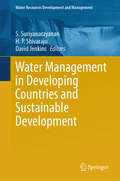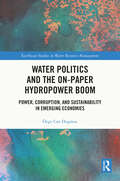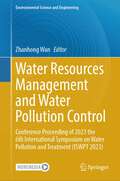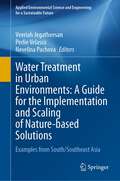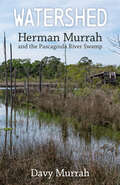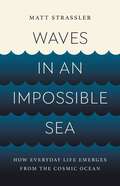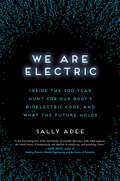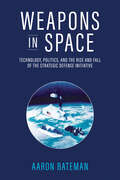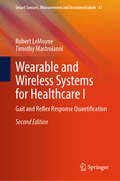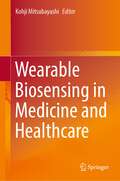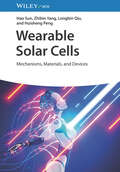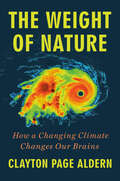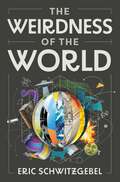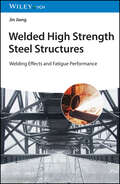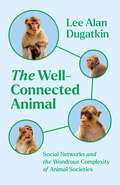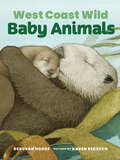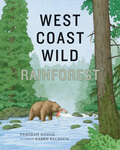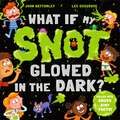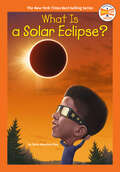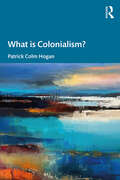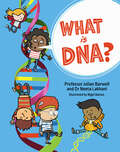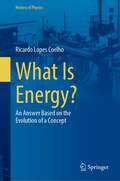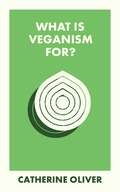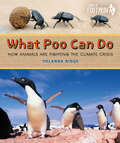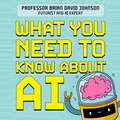- Table View
- List View
Water Management in Developing Countries and Sustainable Development (Water Resources Development and Management)
by David Jenkins S. Suriyanarayanan H. P. ShivarajuThis book provides information on sustainable water resource management strategies that present innovative ways to conserve both quality and quantity of water in developing countries. The book comprises of 24 chapters contributed by authors from 14 countries, namely, Cameroon, China, Cyprus, India, Indonesia, Italy, Namibia, the Netherlands, Norway, Portugal, South Africa, the United Kingdom, the United States of America and Zimbabwe. This book will be of great interest to researchers, practitioners, water resource managers, policy and decision makers, international institutions, governmental and non-governmental organizations, educators, as well as students.
Water Politics and the On-Paper Hydropower Boom: Power, Corruption, and Sustainability in Emerging Economies (Earthscan Studies in Water Resource Management)
by Özge Can DogmusThis book examines how the on-paper hydropower boom impacts the safe and fair access to water and energy in emerging economies.The global hydropower boom is largely made up of small hydropower plants located in emerging economies, but a lack of funding, over-ambitious planning, and corruption have halted the production of these projects. Describing this state as the ‘on-paper’ hydropower boom, this book shifts attention to the hydrosocial problems arising from hydropower projects that remain on paper. It examines how these proposed but unbuilt projects can lead to disruptions in the control and governance of water resources and increase the international dependence of emerging countries due to deep problems in their sustainable development planning and how all this can affect both ecosystems and the communities that depend on them. In doing so, it critically examines the dominant discourses on energy security and sustainable development, emphasises the extent to which the effects of global imperialism are at play, and examines the effects of international power relations in the hydrosocial context and their implications for perpetuating international relations of dependency. Further, this book provides a unique perspective on the global hydropower boom by highlighting that although the global hydropower boom largely remains on paper, it can still have a significant impact on human–water systems. Contributing to the debate on hydrosocial relationships, each chapter offers an insightful examination of the social, cultural, and political interactions that humans have with water and uses these insights to provide a nuanced understanding of the challenges and issues associated with on-paper plans.This book will be of great interest to students and scholars of water politics, water governance, political ecology, corruption and environmental economics, as well as sustainable development policymakers.
Water Resources Management and Water Pollution Control: Conference Proceeding of 2023 the 6th International Symposium on Water Pollution and Treatment (ISWPT 2023) (Environmental Science and Engineering)
by Zhanhong WanThis book features select peer-reviewed proceedings from the 6th International Symposium on Water Pollution and Treatment (ISWPT 2023). It comprises articles written by researchers, practitioners, policymakers and entrepreneurs that examine recent advancements in water pollution and treatment. The book covers a range of topics, including the impact of climate change on water pollution and technologies for reducing greenhouse emissions in water and wastewater treatment. Additionally, it explores water resources planning and management, water quality protection and technologies and processes that control water pollution. This book is useful for beginners, researchers and professionals working in the area of water pollution management, policy and governance.
Water Treatment in Urban Environments: Examples from South/Southeast Asia (Applied Environmental Science and Engineering for a Sustainable Future)
by Veeriah Jegatheesan Perlie Velasco Nevelina PachovaThe value of implementing nature-based solutions (NbS) for water treatment in urban environments is increasingly recognized due to the multiple ecosystem services and societal benefits they provide. The successful implementation of NbS for urban water treatment, however, depends on a range of diverse technical and societal factors that need to be taken into account. Those vary by the type of NbS implemented, the societal challenges the NbS are designed to address and the local ecological, socio-economic and political context, in which the solutions are implemented. This book provides a collection of guidelines for the implementation of three types of NbS for water treatment in urban environments across cities in South/Southeast Asia, namely constructed wetlands, green roofs and floating treatment wetlands. The guides were developed based on existing experiences with the establishment, operation, and maintenance of those three types of NbS in three different countriesin South/Southeast Asia and the lessons learnt from their implementation. They provide detailed outlines of suggested steps for ensuring successful implementation in the respective local contexts. Those include overall planning schemes, surveys for socio-economic evaluations, suggested methods for construction and associated costs, required maintenance as well as a range of operational monitoring parameters. It also includes examples of approaches for the scaling of the three types of NbS discussed in the book in their respective local contexts. This book is expected to benefit local government units and contractors, and other stakeholders involved in NbS implementation and up-scaling, as well as researchers and postgraduate students who plan to conduct pilot-scale studies on NbS.
Watershed: Herman Murrah and the Pascagoula River Swamp
by Davy MurrahThe Pascagoula River is the largest unobstructed river in the contiguous United States. Because of this lack of restraint, the river has been left to rise and fall naturally with the seasons, overflowing annually into the adjoining bottomland forest. This phenomenon makes the Pascagoula River one of the wildest rivers, surrounded by some of the most ecologically diverse woodlands, in North America.Herman Murrah (1935–2002) lived his entire life on the banks and in the swamp surrounding this river in southeast Mississippi. Watershed: Herman Murrah and the Pascagoula River Swamp recounts pivotal moments in Herman’s life and in Mississippi’s conservation history more broadly. In this book, Herman’s eldest son, Davy, details the adventures that continue to inspire young conservationists in the fight to protect our remaining natural ecosystems.As a young adult, Herman worked as a game warden in the Pascagoula River Swamp. When the Pascagoula Hardwood Company, then owners of the swamp, decided to sell the vast tract of forest for clearcutting, Herman was incensed. Determined to protect this natural wonder, Herman teamed up with other visionaries to persuade the State of Mississippi to purchase the land and preserve it in perpetuity to the benefit of future generations of humans and wildlife alike. Eventually, the state agreed and finalized the purchase. Herman was appointed area manager for the upper portion of the newly designated Pascagoula River Wildlife Management Area. He dedicated the remainder of his life to preserving, protecting, and improving the swamp for the good of south Mississippi.
Waves in an Impossible Sea: How Everyday Life Emerges from the Cosmic Ocean
by Matt StrasslerA theoretical physicist takes readers on an awe-inspiring journey—found in "no other book" (Science)—to discover how the universe generates everything from nothing at all: "If you want to know what's really going on in the realms of relativity and particle physics, read this book" (Sean Carroll, author of The Biggest Ideas in the Universe). In Waves in an Impossible Sea, physicist Matt Strassler tells a startling tale of elementary particles, human experience, and empty space. He begins with a simple mystery of motion. When we drive at highway speeds with the windows down, the wind beats against our faces. Yet our planet hurtles through the cosmos at 150 miles per second, and we feel nothing of it. How can our voyage be so tranquil when, as Einstein discovered, matter warps space, and space deflects matter? The answer, Strassler reveals, is that empty space is a sea, albeit a paradoxically strange one. Much like water and air, it ripples in various ways, and we ourselves, made from its ripples, can move through space as effortlessly as waves crossing an ocean. Deftly weaving together daily experience and fundamental physics—the musical universe, the enigmatic quantum, cosmic fields, and the Higgs boson—Strassler shows us how all things, familiar and unfamiliar, emerge from what seems like nothing at all. Accessible and profound, Waves in an Impossible Sea is the ultimate guide to our place in the universe.
We Are Electric: Inside the 200-Year Hunt for Our Body's Bioelectric Code, and What the Future Holds
by Sally AdeeScience journalist Sally Adee breaks open the field of bioelectricity—the electric currents that run through our bodies and every living thing—its misunderstood history, and why new discoveries will lead to new ways around antibiotic resistance, cleared arteries, and new ways to combat cancer. You may be familiar with the idea of our body's biome: the bacterial fauna that populate our gut and can so profoundly affect our health. In We Are Electric we cross into new scientific understanding: discovering your body's electrome. Every cell in our bodies—bones, skin, nerves, muscle—has a voltage, like a tiny battery. It is the reason our brain can send signals to the rest of our body, how we develop in the womb, and why our body knows to heal itself from injury. When bioelectricity goes awry, illness, deformity, and cancer can result. But if we can control or correct this bioelectricity, the implications for our health are remarkable: an undo switch for cancer that could flip malignant cells back into healthy ones; the ability to regenerate cells, organs, even limbs; to slow aging and so much more. The next scientific frontier might be decrypting the bioelectric code, much the way we did the genetic code. Yet the field is still emerging from two centuries of skepticism and entanglement with medical quackery, all stemming from an 18th-century scientific war about the nature of electricity between Luigi Galvani (father of bioelectricity, famous for shocking frogs) and Alessandro Volta (inventor of the battery). In We Are Electric, award-winning science writer Sally Adee takes readers through the thrilling history of bioelectricity and into the future: from the Victorian medical charlatans claiming to use electricity to cure everything from paralysis to diarrhea, to the advances helped along by the giant axons of squids, and finally to the brain implants and electric drugs that await us—and the moral implications therein. The bioelectric revolution starts here.
Weapons in Space: Technology, Politics, and the Rise and Fall of the Strategic Defense Initiative
by Aaron BatemanA new and provocative take on the formerly classified history of accelerating superpower military competition in space in the late Cold War and beyond.In March 1983, President Ronald Reagan shocked the world when he established the Strategic Defense Initiative (SDI), derisively known as &“Star Wars,&” a space-based missile defense program that aimed to protect the US from nuclear attack. In Weapons in Space, Aaron Bateman draws from recently declassified American, European, and Soviet documents to give an insightful account of SDI, situating it within a new phase in the militarization of space after the superpower détente fell apart in the 1970s. In doing so, Bateman reveals the largely secret role of military space technologies in late–Cold War US defense strategy and foreign relations.In contrast to existing narratives, Weapons in Space shows how tension over the role of military space technologies in American statecraft was a central source of SDI&’s controversy, even more so than questions of technical feasibility. By detailing the participation of Western European countries in SDI research and development, Bateman reframes space militarization in the 1970s and 1980s as an international phenomenon. He further reveals that even though SDI did not come to fruition, it obstructed diplomatic efforts to create new arms control limits in space. Consequently, Weapons in Space carries the legacy of SDI into the post–Cold War era and shows how this controversial program continues to shape the global discourse about instability in space—and the growing anxieties about a twenty-first-century space arms race.
Wearable and Wireless Systems for Healthcare I: Gait and Reflex Response Quantification (Smart Sensors, Measurement and Instrumentation #47)
by Timothy Mastroianni Robert LeMoyneThis book is the second edition of the one originally published in 2017. The original publication features the discovery of numerous novel applications for the use of smartphones and portable media devices for the quantification of gait, reflex response, and an assortment of other concepts that constitute first-in-the-world applications for these devices. Since the first edition, numerous evolutions involving the domain of wearable and wireless systems for healthcare have transpired warranting the publication of the second edition. This volume covers wearable and wireless systems for healthcare that are far more oriented to the unique requirements of the biomedical domain. The paradigm-shifting new wearables have been successfully applied to gait analysis, homebound therapy, and quantifiable exercise. Additionally, the confluence of wearable and wireless systems for healthcare with deep learning and neuromorphic applications for classification is addressed. The authors expect that these significant developments make this book valuable for all readers.
Wearable Biosensing in Medicine and Healthcare
by Kohji MitsubayashiThis book contains chapters on wearable biomedical sensors and their assistive technologies for promoting behavioral change in medical and health care. Part I reviews several wearable biomedical sensors based on biocompatible materials and nano and micro-electromechanical systems (MEMS) technologies in the medical and dental fields. Part II introduces the latest approaches to wearable biosensing using unique devices for various skin targets such as sweat, interstitial fluid, and transcutaneous gases. Part III presents technologies supporting wearable sensors, including soft and flexible materials, manufacturing methods, skin volatile-marker imaging, and energy harvesting devices.This book is intended for graduate students, academic researchers, and professors that work in medical and healthcare research fields, as well as industry professionals involved in the development of wearable and flexible sensing devices and measurement systems for human bio/chemical sensing, medical monitoring, and healthcare services, and for medical professionals and government officials who are driving behavior change in health care.
Wearable Solar Cells: Mechanisms, Materials, and Devices
by Hao Sun Zhibin Yang Longbin Qiu Huisheng PengWearable Solar Cells Understand a groundbreaking new energy technology Solar energy is one of the most important paths to a sustainable future. In recent years, extensive research and development has begun to produce wearable solar cells, whose novel planar and fiber format gives them enormous flexibility and a wide range of potential uses. The possibility of a solar energy source that can be fitted to the human body promises to become an extraordinary tool for meeting various kinds of personal energy needs. Wearable Solar Cells: Mechanisms, Materials, and Devices serves as a comprehensive introduction to this cutting-edge technology and its applications. Recent research pointing towards fiber-format solar cells as a bold new frontier is summarized and explored. The result is an essential resource for both experienced researchers and newcomers to the field. Wearable Solar Cells readers will also find: Close coverage of integrated energy harvesting and storage devices Detailed discussion of dye-sensitized solar cells, polymer solar cells, perovskite solar cells, and more An authorial team with decades of combined research experience Wearable Solar Cells is ideal for materials scientists, polymer chemists, electrical engineers, solid-state physicists, and advanced students interested in these and related topics.
The Weight of Nature: How a Changing Climate Changes Our Brains
by Clayton Page AldernA deeply reported, eye-opening book about climate change, our brains, and the weight of nature on us all. The march of climate change is stunning and vicious, with rising seas, extreme weather, and oppressive heat blanketing the globe. But its effects on our very brains constitute a public-health crisis that has gone largely unreported. Based on seven years of research, this book by the award-winning journalist and trained neuroscientist Clayton Page Aldern, synthesizes the emerging neuroscience, psychology, and behavioral economics of global warming and brain health. A masterpiece of literary journalism, this book shows readers how a changing environment is changing us today, from the inside out. Aldern calls it the weight of nature. Hotter temperatures make it harder to think clearly and problem-solve. They increase the chance of impulsive violence. Immigration judges are more likely to reject asylum applications on hotter days. Umpires, to miss calls. Air pollution, heatwaves, and hurricanes can warp and wear on memory, language, and sensory systems; wildfires seed PTSD. And climate-fueled ecosystem changes extend the reach of brain-disease carriers like mosquitos, brain-eating amoebas, and the bats that brought us the mental fog of long COVID. How we feel about climate change matters deeply; but this is a book about much more than climate anxiety. As Aldern richly details, it is about the profound, direct action of global warming on our brains and behavior—and the most startling portrait yet of unforeseen environmental influences on our minds. From farms in the San Joaquin Valley and public schools across the United States to communities in Norway&’s Arctic, the Micronesian islands, and the French Alps, this book is an unprecedented portrait of a global crisis we thought we understood.
The Weirdness of the World
by Eric SchwitzgebelHow all philosophical explanations of human consciousness and the fundamental structure of the cosmos are bizarre—and why that&’s a good thingDo we live inside a simulated reality or a pocket universe embedded in a larger structure about which we know virtually nothing? Is consciousness a purely physical matter, or might it require something extra, something nonphysical? According to the philosopher Eric Schwitzgebel, it&’s hard to say. In The Weirdness of the World, Schwitzgebel argues that the answers to these fundamental questions lie beyond our powers of comprehension. We can be certain only that the truth—whatever it is—is weird. Philosophy, he proposes, can aim to open—to reveal possibilities we had not previously appreciated—or to close, to narrow down to the one correct theory of the phenomenon in question. Schwitzgebel argues for a philosophy that opens.According to Schwitzgebel&’s &“Universal Bizarreness&” thesis, every possible theory of the relation of mind and cosmos defies common sense. According to his complementary &“Universal Dubiety&” thesis, no general theory of the relationship between mind and cosmos compels rational belief. Might the United States be a conscious organism—a conscious group mind with approximately the intelligence of a rabbit? Might virtually every action we perform cause virtually every possible type of future event, echoing down through the infinite future of an infinite universe? What, if anything, is it like to be a garden snail? Schwitzgebel makes a persuasive case for the thrill of considering the most bizarre philosophical possibilities.
Welded High Strength Steel Structures: Welding Effects and Fatigue Performance
by Jin JiangWelded High Strength Steel Structures Understand the impact of fatigue on high strength steel joints with this comprehensive overview High strength steels are highly sought after for industrial and engineering applications ranging from armored vehicles to welded engineering components built to withstand considerable stress. The mechanical properties of welded joints made from high strength steel are integrally linked to the specific welding process, which can have an enormous impact on fatigue performance. Welded High Strength Steel Structures: Welding Effects and Fatigue Performance provides a comprehensive analysis of high strength steel joints and the ramifications of the welding process. It guides readers through the process of performing thermal analysis of high strength steel structures and evaluate fatigue performance in the face of residual stress. The result is a volume with innumerable use cases in engineering and manufacture. Welded High Strength Steel Structures readers will also find: An author with decades of experience in research and engineering Numerous studies of various classes of high strength steel joints Studies on tubular structures for welding residual stress Welded High Strength Steel Structures is a must-own for welding specialists, materials scientists, mechanical engineers, and researchers or industry professionals in related fields.
The Well-Connected Animal: Social Networks and the Wondrous Complexity of Animal Societies
by Lee Alan DugatkinAn engaging exploration of the wondrous social webs that permeate life in animal societies around the world. It’s all about who you know. Whether vampire bats sharing blood meals for survival, field crickets remembering champion fighters, macaque monkeys forming grooming pacts after a deadly hurricane, or great tit birds learning the best way to steal milk—it pays to be well connected. In this tour of the animal kingdom, evolutionary biologist Lee Alan Dugatkin reveals a new field of study, uncovering social networks that existed long before the dawn of human social media. He accessibly describes the latest findings from animal behavior, evolution, computer science, psychology, anthropology, genetics, and neurobiology, and incorporates interviews and insights from researchers he finds swimming with manta rays, avoiding pigeon poop, and stopping monkeys from stealing iPads. With Dugatkin as our guide, we investigate social networks in giraffes, elephants, kangaroos, Tasmanian devils, whales, bats, and more. From animal networks in Australia and Asia to Africa, Europe, and the Americas, The Well-Connected Animal is an eye-opening exposé of wild friends, enemies, and everything in between.
West Coast Wild Baby Animals (West Coast Wild)
by Deborah HodgeMeet the wild baby animals of the Pacific west coast! Wolf pups, bear cubs, whale calves and eaglets are thriving in the ancient rainforest, rugged beach and majestic ocean of the Pacific west coast. This sweet introduction to baby animal names and behaviours, with gorgeous watercolor scenes, will delight toddlers and babies everywhere! Key Text Features illustrations
West Coast Wild Rainforest (West Coast Wild #5)
by Deborah HodgeStep into the majestic rainforest of the Pacific west coast and discover a unique community of creatures thriving in an interconnected web of life. Towering over the sea, along the magnificent Pacific west coast, is an ancient and beautiful rainforest with a unique ecosystem that is linked in many ways. In this fourth book in the West Coast Wild series, you will find trees as tall as twenty-storey buildings, tiny seedlings sprouting on nursery logs and brightly colored salmon spawning in streams. The salmon, as a keystone species, connect the ocean to the forest and provide a rich source of food for the bears, wolves, eagles and other creatures that live in this pristine wilderness. The remains of the fish add vital nutrients to the forest, feeding the lush green plants and trees. In turn, the thick vegetation shades the streams and protects the baby salmon that hatch and swim to the sea. Author Deborah Hodge provides a clear and engaging look at the interdependence of the forest species and the fascinating cycles of nature in this rare ecosystem, while Karen Reczuch’s lavish watercolors show the rainforest teeming with life in shades of green that can only come from receiving more than ten feet of rain a year. Key Text Features illustrations author’s note further information further reading facts Correlates to the Common Core State Standards in English Language Arts: CCSS.ELA-LITERACY.RI.K.3 With prompting and support, describe the connection between two individuals, events, ideas, or pieces of information in a text. CCSS.ELA-LITERACY.RI.K.7 With prompting and support, describe the relationship between illustrations and the text in which they appear (e.g., what person, place, thing, or idea in the text an illustration depicts). CCSS.ELA-LITERACY.RI.1.3 Describe the connection between two individuals, events, ideas, or pieces of information in a text. CCSS.ELA-LITERACY.RI.1.4 Ask and answer questions to help determine or clarify the meaning of words and phrases in a text.
What If My Snot Glowed in the Dark?
by John BottomleyEverybody pees, poos and pukes, and everyone has icky skin and smells horrible. But have you ever wondered what would happen if your burps could power a hot air balloon? You could burp your way across the country! Or what if your farts smelled like roses? Well, you could grow a fart garden, or start a range of perfumes inspired by your farts. Or what if you never, EVER showered again? (Please, do make sure you shower regularly!) With plenty hilarious, yucky facts to discover about the gross stuff that comes out of you, budding young scientists - and comedians! - can learn all about why their bodies do icky, sticky things. What if My Snot was Glow in the Dark? really puts the FUN in bodily functions.
What Is a Solar Eclipse? (Who HQ Now)
by Dana Meachen Rau Who HQLearn about the phenomenon of a solar eclipse just in time for the Great American Eclipse that will take place on April 8, 2024 in this title in the Who HQ Now series featuring newsmakers and trending topics.Just in time for the third North American total solar eclipse of the twenty-first century, this book explains how to safely observe solar eclipses, how long eclipses last, and why they result in a blackout period during the day. Young armchair astronomers and astronauts will be inspired by the wonders of outer space and what exists beyond our atmosphere as they learn more about the moon, the sun, and our earth. What really happens during a solar eclipse and how does it affect the energy in our atmosphere? You'll find the most up-to-date eclipse information in this exciting new book.
What is Colonialism?
by Patrick Colm HoganWhat is Colonialism? develops a clear and rigorous account of what colonialism is and how it works. It draws on and synthesizes recent work in cognitive science, affective science, and social psychology, along with Marxism and related forms of analysis. Hogan begins with some fundamental conceptual distinctions, such as the degree to which a group shares beliefs, dispositions, and skills versus the degree to which they share identification with a category. Building on these distinctions, he defines colonialism in terms of political, economic, and cultural autonomy, clarifying the nature of culture and autonomy particularly. He goes on to articulate an invaluable systematic account of the varieties of colonialism. The final chapters outline the motives of imperialists, differentiating these from their ideological rationalizations, and sketching the harms caused by colonialism. The book concludes by considering when, or if, one can achieve a genuinely postcolonial condition. Hogan illustrates these analyses by examining influential literary works—by European writers (such as Joseph Conrad) and by non-Europeans (such as Athol Fugard, Kamala Markandaya, and Wole Soyinka). This accessible and informative volume is the ideal resource for students and scholars interested in colonialism and empire.
What is DNA?
by Professor Julian Barwell Dr Neeta LakhaniA humorous introduction to DNA and genetics, helping children find out what they are made of!DNA is the building block of all life. This book helps children aged 8 plus understand the structure of the DNA chemical, how it works inside the body, how life began on Earth and how all living things are connected by their DNA. With Nigel Baines' hilarious cartoons, the book explores topics such as why some of us really don't like Brussel sprouts - and why some of us love them!; what came first - the chicken or the egg?; and how DNA can solve crimes and make our lives better.Contents: The Great Discovery! / The Code Breakers and the Machines Inside Our Bodies / Babies Come with Instructions / Is it Good to Mix Up Our DNA? / How are Twins Made? / How Did Life on Earth Begin? / What Came First - the Chicken or the Egg? / Are We 50% a Mushroom?/ Is Grandad Really a Dinosaur?/ Why Don't I Like Vegetables?/ How Did I Get Ginger Hair?/ How Much Do Our Genes Affect Us?/ Spot a Relative After 500 Years!/ Traffic Lights - Red! Green! Blue?/ Gene On, Gene Off/ DNA That Makes Diseases / Who Did It!? / Who Is In Charge? / Quiz
What Is Energy?: An Answer Based on the Evolution of a Concept (History of Physics)
by Ricardo Lopes CoelhoThis book provides a solution to the problem with the energy concept. This problem manifests itself in the fact that physicists clearly diverge regarding the question of what energy is. Some define it but others state that we do not know what it is. Although this is a problem for physicists who need to explain the concept, it is not a problem for physics that can be solved by laboratory means. Penetrating into the origin of the notion of energy, this book offers a clear idea of what was discovered and what was invented to interpret the findings.Following the development of the concept, it provides an explanation of the trends in contemporary textbooks. The author's repetition, in his "History and Philosophy of Physics Laboratory", of Joule’s famous experiment – the paddle wheel experiment – with a calorimeter as originally used by Joule and with a calorimeter as proposed in textbooks, is presented, yielding new insight into the phenomenon. Thus, science teachers and students will benefit from reading the book as well as historians, philosophers, students of the history and philosophy of science, and all who are interested in knowing about what it is that we call energy.
What Is Veganism For? (What Is It For?)
by Catherine OliverAcross the world, an increasing number of people are turning to veganism, changing not just their diets, but completely removing animal products from their lives. For some, this is prompted by concerns over animal ethics; for others, it’s a response to the part played by animal agriculture in the climate crisis or an attempt to improve their own health. Catherine Oliver shows why the veganism movement has become a powerful social, political and environmental force, taking an honest look at how we live and eat. She discusses the health and environmental benefits of veganism, explores the practical and social impacts of the shift to eating plants, and explains why veganism is not just a diet, but a way of life.
What Poo Can Do: How Animals Are Fighting the Climate Crisis (Orca Footprints #29)
by Yolanda RidgeWe all know animals are affected by the climate crisis. But did you know the climate crisis is also affected by animals? From whales to dung beetles, What Poo Can Do explores how animals big and small are helping the planet every time they do a number two. Come on a journey to different parts of the world to see how animals are fertilizing plants, storing carbon, preventing fires, reducing methane and even creating color-coded maps—all through their feces! Readers will discover how animal defecation makes a difference when it comes to the climate crisis. It's time to embrace the power of poo!
What You Need to Know About AI: A beginner’s guide to what the future holds
by Brian David JohnsonThe only book you need on AI - for all curious, fact-gobbling kids age 7+.What actually is AI? Will it take over the world? And one day, will it tidy your bedroom...? In this beginner's guide, learn everything you need to know about AI, from how it helps us discover epic stuff up in space or under the sea, whether it will help you build your very own dinosaur, and why, it won't actually help you write your homework! Written by AI expert and Futurist, Brian David Johnson, you will learn what AI is, where it came from, and how it's already being used in the world of sport, space, medicine, animals and more. You will discover AI's amazing possibilities that might shape the future. And along the way, you'll learn super cool facts, bust some myths, and gain a balanced and informed view on the biggest topic of our time.Designed with fun line illustrations throughout.
